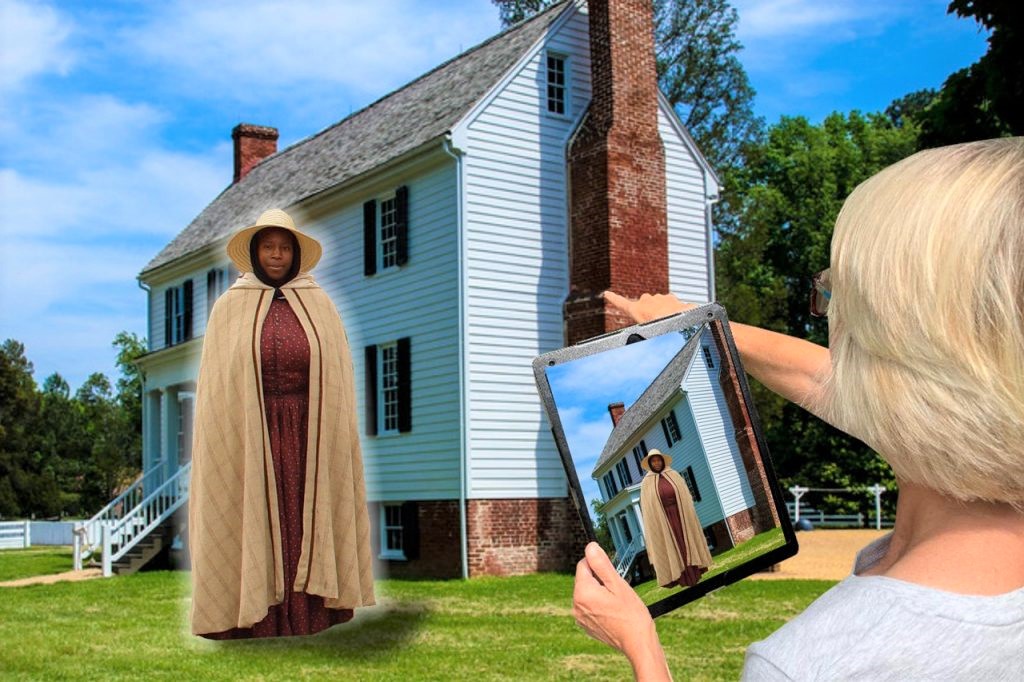
The grass-covered knolls and surrounding woods of the Pamplin Historical Park in Petersburg, Virginia, seems like an unassuming landscape. With its well-kept facilities and trails, the property reveals little of its war-torn past. Only small mounds remain from its Civil War-era fortifications and earthworks. And yet tourists, students on field trips, and history buffs flock to the park, hoping to get a glimpse of its infamous past.
But many do not know that the ground they stand upon holds vital clues. To help reveal a more in-depth picture of the Civil War, the National Endowment for the Humanities is funding a planning grant for “Experiencing Civil War History through Augmented Reality: Soldiers, Civilians, and the Environment at Pamplin Historical Park.” The grant recipients are from Virginia Tech, Virginia Commonwealth University, and the park, along with its National Museum of the Civil War Soldier.
When Paul Quigley, the project director and principal investigator, gazes at the Breakthrough Battlefield at Pamplin Historical Park, he sees a history filled with earthworks, human relationships, and social change.
“We want audiences to think about the battlefield and the homefront as part of the same history,” he said. “What kinds of people, other than soldiers, were involved in the Civil War? What roles did they play, and what effects did the war have on their lives and social relationships? We will tell stories about households, which Civil War-era historians are studying more and more as a venue of transformative social changes tied up with military events.”
Quigley and two overlapping project teams, one focused on humanities and the other on digital media, will work together to provide new technology to bring innovative humanities scholarship to broader audiences. The teams envision using augmented reality to help people understand history within its physical context. Pamplin Historical Park offers a battlefield, four museums, and historic Tudor Hall, which served for a brief time as the Confederate headquarters for the troops in the area.
“This is also a way to get people to think about the impact the environment had on the way battles progressed,” said Quigley, who is the James I. Robertson Jr. Associate Professor of Civil War Studies at Virginia Tech and director of the Virginia Center for Civil War Studies. “The way military commanders used environmental features, ranging from trees, topography, water, and even light, could easily change a battle’s trajectory. The initial stages of the battle took place at night, so the darkness affected the decisions made by military commanders.”
The clash — known as the Breakthrough Battle of Petersburg — took place on April 2, 1865. Quigley said it led to the eventual defeat and surrender of Robert E. Lee’s Confederate troops a week later. This marked the beginning of the end of the war.
Part of the overall grant plan is to include a fortification exercise. Quigley said the earthworks used in this battle were a precursor to the trench warfare of World War I.
“You can see bumps in the ground, usually just a few feet high,” he said, “so not nearly as high as they would have been during the Civil War. Although it’s cool to see where they were, it doesn’t give you a visual sense of exactly what they looked like. So one thing we’re going to do is allow visitors, through augmented reality, to play with different fortifications and ‘add’ them to the landscape.
“Then they will receive audio or visual feedback from historians, who will provide more information,” Quigley said. “And living historians will portray characters from the era — men and women, Black and white people. We can make it so much more interactive than a simple video.”
Quigley said the project is about finding alternative ways to think about military history. This particular site is perfect because it includes both a battleground and a historic plantation. The team will address a variety of questions. What happened to the household during the war when a large majority of men left to fight? In what position did that leave female members of the household?
“How did the war affect the nature of white people’s power over Black people?” Quigley asked. “How did enslaved people leverage the crisis or improve their situation to rebel in some way against slaveholders’ authority? Running away is the obvious one. Even when people didn’t run away, though, their work may have slowed down. They knew the traditional power of the slaveholder over the slave was crumbling, and they used that to their advantage.”
On the teams is Todd Ogle, the associate director for immersive experiences from the Center for Human-Computer Interaction. Since reading a book on the Battle of the Second Manassas 15 years ago, Ogle has wanted to bring historical documents, photographs, and map information, often found in libraries and archives, to light on a Civil War battlefield. This project is providing him with the opportunity.
“At the time, smartphones didn’t exist, and mobile augmented reality was still in the laboratory research and development phase of its lifecycle,” Ogle said. “Even now, sharing such hidden histories has not become widespread even though the technical affordances exist. I’d like to push this out to as wide an audience as possible.”
Written by Leslie King



